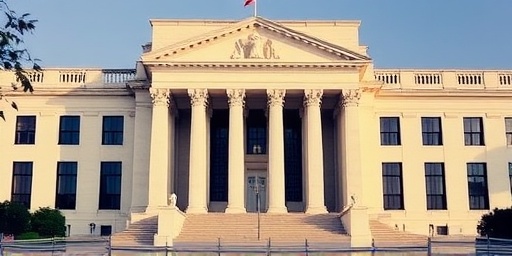In a move that sent ripples through global financial markets, the US Federal Reserve announced on Wednesday that it is considering an interest rate cut as early as December, buoyed by recent data indicating a slowdown in inflation. Chair Jerome Powell emphasized during the post-meeting press conference that while the economy remains robust, the cooling inflation trends provide a window for monetary policy easing. This signal triggered an immediate rally, with the Dow Jones Industrial Average climbing 1.5%, the S&P 500 gaining 1.8%, and the Nasdaq Composite surging 2.2% in afternoon trading.
Fed’s Inflation Data Breakdown Points to Sustainable Decline
The Federal Reserve‘s decision to hold interest rates steady at the current 5.25% to 5.50% range for the fourth consecutive meeting comes against a backdrop of encouraging inflation metrics. The latest Consumer Price Index (CPI) report, released earlier this month, showed headline inflation dipping to 3.2% year-over-year in October, down from 3.7% in September. Core inflation, which excludes volatile food and energy prices, eased to 4.1%, marking the lowest level since early 2022.
Economists attribute this progress to the Fed’s aggressive rate-hiking campaign initiated in March 2022, which has successfully tempered demand without tipping the economy into recession. “We’ve seen inflation move decisively lower across a broad range of goods and services,” Powell stated, highlighting that shelter costs, a stubborn component, have begun to moderate as rental vacancy rates rise. The Producer Price Index (PPI) also reflected this trend, with wholesale inflation falling to 2.2% in October, the slowest pace in over two years.
These figures align with the Fed’s preferred gauge, the Personal Consumption Expenditures (PCE) index, which clocked in at 2.7% for headline and 2.8% for core in September data released last week. While still above the central bank’s 2% target, the trajectory suggests that sustained progress is underway. Federal Reserve officials, in their updated economic projections, lowered their 2024 inflation forecast to 2.5% from 2.8%, signaling growing confidence in the disinflation process.
However, challenges persist. Energy prices remain volatile due to geopolitical tensions in the Middle East, and supply chain disruptions from lingering effects of the pandemic could reignite pressures. Despite these risks, the data underscores a narrative of controlled cooling, setting the stage for potential policy shifts.
Powell’s Cautious Optimism Shapes Rate Cut Expectations
Jerome Powell’s remarks during the Federal Open Market Committee (FOMC) press conference were a masterclass in balanced communication, blending optimism with caution. “The economy is performing well, but we are not out of the woods yet,” Powell said, reiterating that any rate cut would be data-dependent. He pointed to a resilient labor market, with unemployment steady at 4.1% and nonfarm payrolls adding 261,000 jobs in October—far exceeding expectations of 150,000.
Yet, Powell tempered enthusiasm by noting that inflation’s path remains uncertain amid fiscal policy debates ahead of the 2024 elections. The Fed’s dot plot, a graphical representation of policymakers’ rate expectations, showed a median projection of two quarter-point cuts by the end of 2024, up from one in September. This shift implies a possible December move, followed by another in March 2025, bringing the federal funds rate to around 4.75% to 5%.
Market participants interpreted these signals bullishly. Futures markets now price in a 75% probability of a December rate cut, according to CME FedWatch Tool data, a sharp increase from 40% prior to the meeting. “The Fed’s language has pivoted from hawkish to neutral, opening the door for easing,” said Lindsay Rosner, senior macro strategist at Goldman Sachs. Her view is echoed by other analysts, who see the Fed’s dual mandate—maximum employment and price stability—as increasingly aligned for relaxation.
Powell’s emphasis on avoiding premature easing drew from historical lessons. He referenced the 2019 mid-cycle adjustment, which preceded the pandemic-era inflation surge, as a cautionary tale. Nonetheless, his forward guidance has quelled fears of prolonged high rates, fostering a sense of stability in uncertain times.
Wall Street’s Rally Reflects Broader Economic Relief
The announcement catalyzed a broad-based market upswing, with financial stocks leading the charge. Bank of America shares rose 3.2%, while JPMorgan Chase gained 2.8%, as lower interest rates promise improved lending margins and reduced borrowing costs for consumers. Tech giants like Apple and Microsoft also benefited, with gains of over 2%, as investors bet on sustained consumer spending in a lower-rate environment.
Bond markets reacted swiftly too. The 10-year Treasury yield fell to 4.35%, its lowest in six months, from 4.5% pre-announcement, signaling expectations of easier monetary policy. This decline eases mortgage rates, which hovered around 7% recently, potentially unlocking pent-up housing demand. Real estate investment trusts (REITs) surged 2.5% on average, underscoring the sector’s sensitivity to rate changes.
Globally, the reaction was positive but muted. European indices like the FTSE 100 and DAX climbed 1%, while Asian markets, including Japan’s Nikkei, extended gains into Thursday. Currency traders saw the US dollar weaken against the euro and yen, dropping 0.8% and 1.1%, respectively, as rate cut prospects diminish the greenback’s appeal.
Retail investors piled in via platforms like Robinhood, with trading volume spiking 40% above average. Social media buzzed with optimism, though some voices warned of overreaction. “Markets are pricing in perfection, but the Fed could still surprise,” cautioned Mohamed El-Erian, chief economic advisor at Allianz. Despite such notes, the rally highlights how intertwined Federal Reserve decisions are with investor sentiment and portfolio strategies.
Key Economic Metrics Bolstering the Case for Rate Relief
Delving deeper into the data, several indicators reinforce the Federal Reserve’s rationale for contemplating a rate cut. Gross Domestic Product (GDP) growth for the third quarter came in at a robust 2.8% annualized rate, surpassing forecasts and demonstrating economic resilience despite 16 months of elevated interest rates. Consumer spending, which drives two-thirds of the economy, rose 3.1%, supported by wage gains outpacing inflation for the first time in years.
The labor market’s strength is particularly telling. Average hourly earnings increased 4% year-over-year in October, but with inflation cooling, real wage growth stands at 0.8%—a positive for household finances. Job openings, per the JOLTS report, fell to 8.8 million, suggesting a softening but not distressed market, aligning with the Fed’s soft-landing hopes.
Manufacturing and services sectors also show stabilization. The Institute for Supply Management’s (ISM) manufacturing PMI rose to 48.5 in October from 47.2, inching closer to expansion territory above 50. Services PMI hit 54.7, indicating healthy demand without overheating. These metrics collectively paint a picture of an economy adapting to higher rates without breaking, giving the Fed room to maneuver.
- Inflation Trends: CPI at 3.2%, core at 4.1%—downward trajectory evident.
- Employment Data: Unemployment at 4.1%, payrolls +261K—resilient yet balanced.
- Growth Indicators: Q3 GDP +2.8%, consumer spending +3.1%—sustained momentum.
- Global Context: Weaker international growth tempers US export pressures.
Experts like those at the Brookings Institution argue that these figures reduce the risk of stagflation, a scenario where inflation persists alongside economic stagnation. Instead, the data supports a gradual normalization of interest rates, potentially averting deeper downturns.
Future Policy Shifts and Their Ripple Effects on Everyday Americans
Looking ahead, the Federal Reserve’s signals open avenues for broader economic relief. A December rate cut could lower monthly payments on adjustable-rate debts, from credit cards averaging 21% APR to auto loans at 7.5%. For the 1.7 million Americans with student loans restarting payments, reduced rates might ease the burden, freeing up disposable income for spending and savings.
Homeowners and buyers stand to gain most. With 30-year fixed mortgage rates potentially dipping below 6.5% by year-end, the housing market—frozen by high costs—could thaw. The National Association of Realtors estimates that every 1% drop in rates could bring 1.5 million additional buyers into the fray, revitalizing construction and related industries.
Businesses, too, anticipate benefits. Smaller firms, surveyed by the National Federation of Independent Business, cite high interest rates as a top concern; easing could spur investment in equipment and hiring. Larger corporations might accelerate share buybacks, further fueling stock gains.
Yet, risks loom. If inflation rebounds—perhaps from proposed tariffs or supply shocks—the Fed could pause cuts, prolonging uncertainty. Policymakers will scrutinize November’s jobs report and December’s CPI before the next meeting. Internationally, coordinated easing with the European Central Bank and Bank of England could stabilize trade, but divergent paths might spark currency wars.
For investors, diversification remains key. While rate-sensitive sectors like utilities and real estate shine, tech and cyclicals could extend rallies if growth holds. Retirees relying on fixed-income assets may see bond values rise, but savers in high-yield accounts face lower returns. Overall, the Fed’s pivot heralds a new chapter, one where cooling inflation paves the way for interest rate relief, fostering optimism for 2025’s economic landscape.









